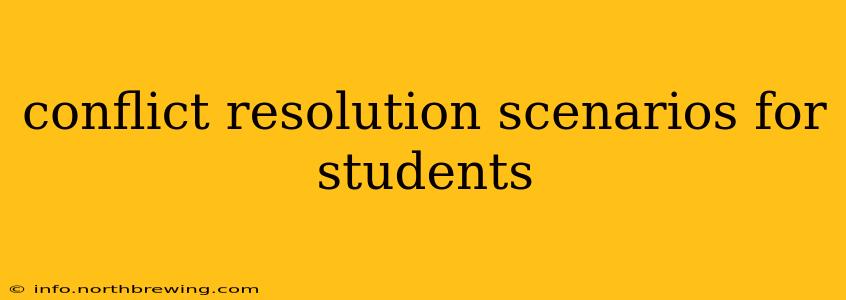Conflict is an inevitable part of life, and learning to navigate disagreements constructively is a crucial life skill. This guide provides a range of conflict resolution scenarios for students, suitable for various age groups and learning environments. We'll explore different scenarios, discuss effective strategies, and provide practical tips for educators to facilitate learning and growth.
Why Teach Conflict Resolution to Students?
Teaching students effective conflict resolution skills equips them with tools to:
- Improve relationships: By learning to manage disagreements respectfully, students can build stronger and healthier relationships with peers, teachers, and family members.
- Enhance communication: Conflict resolution necessitates clear and assertive communication, fostering better understanding and empathy.
- Reduce bullying and aggression: Equipping students with conflict resolution skills can decrease instances of bullying and other aggressive behaviors.
- Promote a positive learning environment: A classroom where students feel safe and supported to resolve conflicts fosters a more productive and positive learning experience for everyone.
- Develop essential life skills: These skills are transferable to all aspects of life, from personal relationships to professional settings.
Conflict Resolution Scenarios for Students
Here are some scenarios, categorized by age group and complexity, designed to facilitate discussion and practice:
Elementary School (Grades K-5)
Scenario 1: The Shared Toy
- Situation: Two students, Sarah and Tom, both want to play with the same toy. They both start crying and pulling at the toy.
- Discussion Points: How can Sarah and Tom share the toy? Can they take turns? What happens if they can't agree? What are some kind words they can say to each other?
Scenario 2: The Playground Dispute
- Situation: During recess, Alex pushes Ben off the swing. Ben is hurt and angry.
- Discussion Points: How did Alex's action make Ben feel? What could Alex have done differently? What can Ben do to express his feelings to Alex? How can they both play on the swings without hurting each other?
Middle School (Grades 6-8)
Scenario 3: The Gossip Chain
- Situation: A rumour spreads through the school about Maria. It's untrue, but it's causing Maria significant emotional distress.
- Discussion Points: How does gossip affect individuals and the school community? What are the consequences of spreading rumours? What steps can be taken to stop the rumour and support Maria? How can you address someone spreading gossip?
Scenario 4: The Cheating Incident
- Situation: During a test, David copies answers from Emily's paper. Emily is upset and unsure how to handle the situation.
- Discussion Points: Why is cheating wrong? How does it affect Emily and the fairness of the test? What are the possible consequences of cheating? How can Emily address the situation with David and/or the teacher?
High School (Grades 9-12)
Scenario 5: The Group Project Conflict
- Situation: In a group project, one student, John, doesn't contribute equally. His teammates are frustrated and their grade is at risk.
- Discussion Points: How can the team address John's lack of contribution? What strategies can be used to foster teamwork and equal participation? What are the consequences of unequal contributions? How can they negotiate responsibilities and deadlines fairly?
Scenario 6: The Social Media Dispute
- Situation: Two students, Lisa and Chloe, have an argument that spills over onto social media, leading to hurtful comments and cyberbullying.
- Discussion Points: What are the ethical implications of online conflict? How can they resolve their argument constructively and respectfully? What steps can they take to de-escalate the situation and prevent further harm? What are the school's policies on cyberbullying?
Strategies for Effective Conflict Resolution
- Active Listening: Encourage students to truly listen to each other's perspectives without interrupting.
- Empathy: Help students understand and share the feelings of others involved in the conflict.
- Compromise: Encourage finding solutions where both parties feel heard and their needs are partially met.
- Assertiveness: Teach students to express their needs and feelings clearly and respectfully.
- Non-violent Communication: Focus on using "I" statements to describe feelings and needs without blaming others.
- Seeking Mediation: In more complex situations, a neutral third party can help facilitate a resolution.
Frequently Asked Questions (FAQ)
How can I incorporate conflict resolution into my classroom?
Regularly discuss scenarios, role-play situations, and provide opportunities for students to practice these skills in real-life classroom interactions.
What are the signs of unresolved conflict?
Look for increased tension, decreased communication, avoidance of certain students, or outbursts of anger or frustration.
How can I create a safe space for students to discuss conflict?
Establish clear classroom rules emphasizing respect, empathy, and active listening. Ensure confidentiality where appropriate and offer support.
By incorporating these scenarios and strategies into your teaching, you can empower your students with the essential life skills of conflict resolution, fostering a positive and productive learning environment for all.
